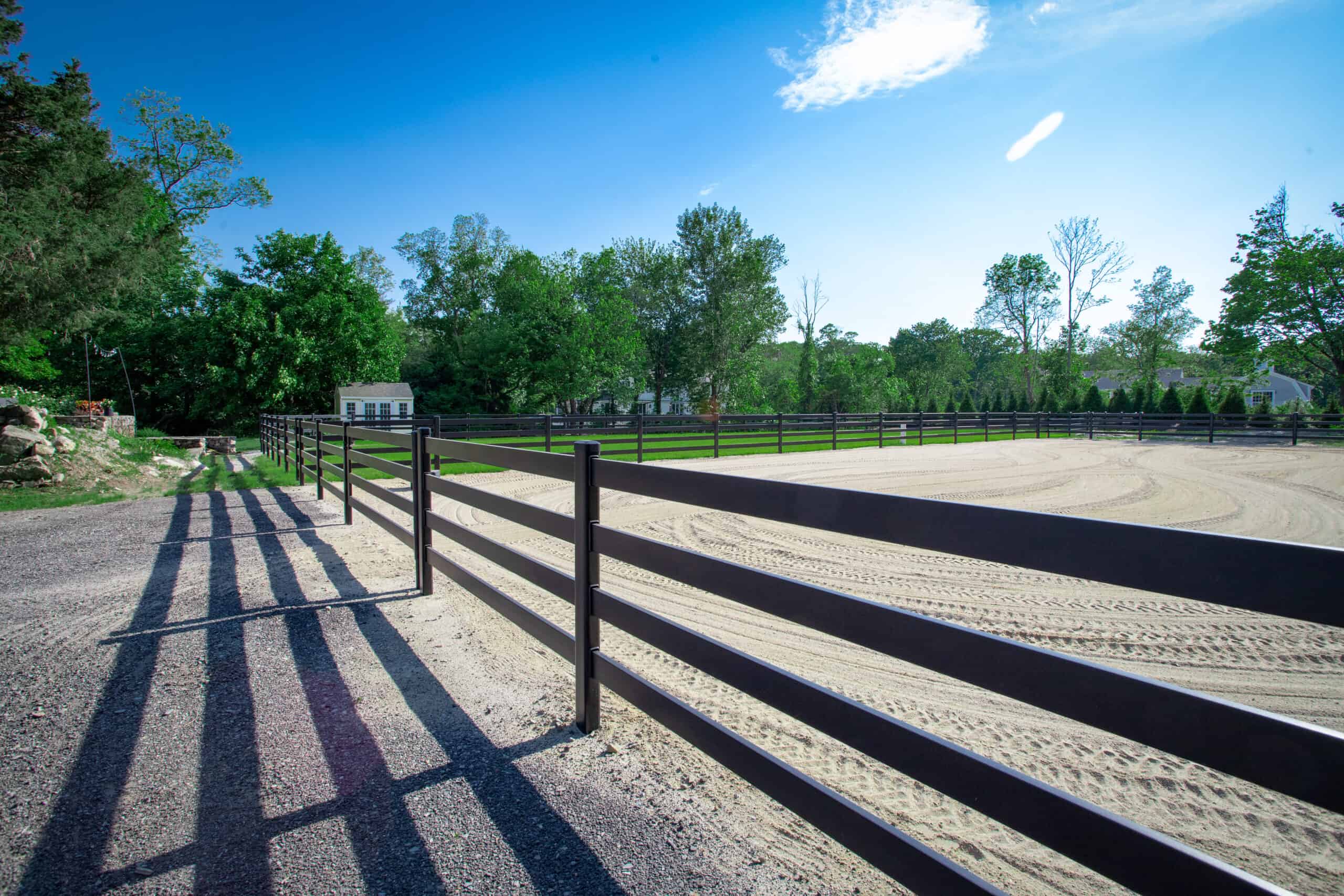Coastal properties are stunning, until you start maintaining them. That ocean breeze everyone loves carries salt that attacks your fencing relentlessly, 24 hours a day, 365 days a year. What works inland fails fast near the coast, and most ranchers learn this lesson the expensive way.
We’ve watched beautiful fences deteriorate into rust-stained eyesores within five years of installation. Wood that splits and warps from constant humidity. Metal that looks solid until you lean against it and it crumbles. Wire that snaps under minimal pressure because corrosion hollowed it out from the inside.
Coastal fencing isn’t about finding something good enough. It’s about understanding that salt air is actively trying to destroy whatever you install, and choosing materials engineered to win that fight.
Because out here, second place means replacement, and replacement near the coast costs more than getting it right the first time.
What Makes Coastal Environments Destructive
Salt doesn’t just sit on surfaces. Nope, it infiltrates, penetrates, and attacks from within. Airborne salt particles settle on your fencing, absorb moisture from humid air, and create an aggressive electrolyte solution that accelerates corrosion exponentially.
The closer to the ocean, the worse it gets. Properties within a quarter-mile face the harshest conditions, but salt air effects extend miles inland. Morning dew and fog carry salt deep into your property, settling on fencing that never sees direct ocean spray.
Temperature cycling compounds the problem. Coastal areas experience constant expansion and contraction as temperatures shift between day and night. This movement works salt deeper into microscopic surface imperfections, breaking down protective coatings from the inside out.
High humidity prevents fencing from ever truly drying. Surfaces stay damp, maintaining the electrolyte solution that drives corrosion. What might take twenty years to rust through inland happens in five near the coast.
Materials That Fail Fast in Coastal Conditions
Understanding what doesn’t work saves you from expensive mistakes.
- Standard Galvanized Wire: Inland, it lasts 15-20 years. But near the coast, and you’ll see rust within three years, complete failure by year seven. The zinc coating sacrifices itself quickly under salt attack, leaving bare steel exposed.
- Wood Fencing: Split rail and board fencing rot faster in coastal humidity. Salt pulls moisture into wood fibers, keeping them perpetually damp. Even pressure-treated lumber shows deterioration within 7-10 years. Cedar and redwood last slightly longer but still fail prematurely.
- Vinyl Fencing: Seems like a smart coastal choice until UV exposure and salt air make it brittle. Vinyl fencing becomes increasingly fragile over time, cracking and shattering under impact. The constant humidity also encourages mold and mildew growth that’s nearly impossible to clean.
- Chain Link: Budget-friendly inland, a maintenance nightmare near the coast. Even vinyl-coated chain link fails once the coating cracks—and it will crack from salt exposure and temperature cycling. Rusted chain link looks terrible and provides poor containment for livestock.
- Painted Metal: Paint offers minimal protection against salt air. It chips, cracks, and weathers rapidly in coastal conditions. Constant repainting becomes an expensive, never-ending cycle that still doesn’t prevent underlying corrosion.
- Aluminum: Naturally corrosion-resistant but structurally inadequate for horses and livestock. Aluminum fencing also suffers from pitting corrosion in salt environments, creating rough surfaces and weakening structural integrity over time.
The Best Coastal Fencing Options
Coastal fencing demands marine-grade thinking: materials and protective systems designed to withstand the ocean’s assault without compromise.
- Stainless Steel: Works beautifully but costs 3-5 times more than alternatives. Marine-grade 316 stainless offers exceptional salt resistance, but the price puts it beyond most ranch budgets. It’s overkill for most applications anyway.
- Fiberglass: Increasingly popular for coastal horse fencing. Won’t rust or rot, maintains flexibility, and stands up to salt exposure. The downside is appearance—it lacks the traditional aesthetic most property owners prefer. Also expensive and can become brittle over years of UV exposure.
- Properly Protected Steel: Steel with dual-layer marine-grade protection (hot-dip galvanization plus architectural powder coating) creates a barrier system that salt air can’t penetrate. This is what actually works without breaking the bank.
The key is redundancy. Single-layer protection fails eventually. Dual-layer systems provide backup when (not if) the outer layer is compromised, extending service life from years to decades.
Why Steel Board Fencing Is the Best for Coastal Applications
We engineered our Steel Board fencing specifically to survive the harshest environments, and that includes coastal properties where other fencing fails fast.
It starts with heavy-gauge steel, substantial enough to contain horses while providing the mass needed for long-term durability. That steel gets hot-dip galvanized with thick zinc coating (not the thin electroplating that fails in salt air), but comprehensive G-90 or higher protection that bonds molecularly to the steel.
Then comes architectural-grade powder coating in your choice of colors. This isn’t decorative (though, it does look good). It’s the outer barrier that seals galvanized steel from salt, moisture, and UV damage. The powder coating we use is the same specification protecting coastal bridges and marine infrastructure. It’s engineered for this exact environment.
The dual-layer protection means salt air must breach both barriers before reaching the steel itself. That doesn’t happen in ten years. It doesn’t happen in twenty. We’ve got coastal installations pushing thirty years without rust, without deterioration, without the failures that plague other materials.
Our board design matters too. Drainage channels prevent water pooling. Connection points are engineered to shed moisture rather than trap it. Posts are designed with coastal conditions in mind—every detail considers how salt and humidity might attack and blocks those pathways.
The smooth surfaces prevent salt accumulation. Unlike textured materials that create pockets where salt settles and concentrates, our boards shed salt with normal rainfall. This passive maintenance feature dramatically extends protection in salt air environments.
Maintenance in Coastal Environments
No fence is completely maintenance-free near the coast, but smart material choices minimize the work required.
- Monthly Rinses: After salt storms or heavy wind events, rinse fencing with fresh water. This simple step removes accumulated salt before it penetrates protective coatings. Takes thirty minutes, adds years to fence life.
- Quarterly Inspections: Walk your fence line looking for coating damage, loose connections, or areas where salt has concentrated. Early detection prevents minor issues from becoming major problems.
- Annual Hardware Check: Salt air loosens connections over time. Once yearly, tighten all bolts and fasteners. Check for corrosion on exposed metal and address it immediately.
- Vegetation Control: Keep grass and brush cleared from fence bases. Vegetation traps moisture and salt against fencing, accelerating deterioration even on resistant materials.
With Steel Board fencing, maintenance stays minimal because the materials resist coastal conditions inherently. You’re checking, not constantly repairing, and that’s the difference quality materials make near the ocean.
Protect Your Coastal Investment
Your coastal property deserves fencing that stands up to salt air without constant replacement. Fencing that maintains its appearance and structural integrity year after year, not just until the next big storm.
We’ve spent years perfecting Steel Board fencing for harsh environments. Every coastal installation proves what proper engineering and quality materials deliver—decades of reliable service without the rust, deterioration, and failures that plague alternatives.
Salt air doesn’t care what the brochure promised. It only cares about finding weakness. Our Steel Board fencing eliminates that weakness with dual-layer marine-grade protection that actually works in real coastal conditions.
When you’re ready to stop replacing failed fencing and start protecting your coastal property properly, give us a call. We’ll show you exactly what marine-grade protection looks like and what it means for your operation’s future.
Frequently Asked Questions
Q. Does coastal fencing require special maintenance?
Rinsing fencing with fresh water after salt storms helps, but isn’t required with properly protected materials. Quarterly inspections and annual hardware checks keep coastal fencing secure. Quality steel board systems require far less maintenance than wood, vinyl, or standard metal alternatives near the coast.
Q. What fence height works best in coastal wind conditions?
Standard 4-5 foot heights work well for most coastal properties. Extremely exposed oceanfront locations may benefit from 4-foot heights to reduce wind load. Proper post depth and spacing matter more than height for wind resistance in coastal areas.
Q. Can I mix materials to save money on coastal fencing?
Use your best materials where salt exposure is highest. That’s typically property perimeters and areas facing prevailing winds. Interior paddocks may allow slightly less aggressive protection. However, mixing vastly different material types creates maintenance headaches and inconsistent property appearance.



